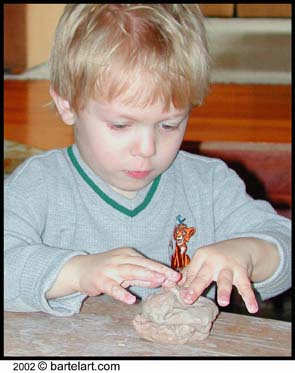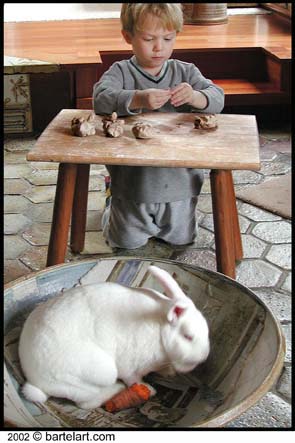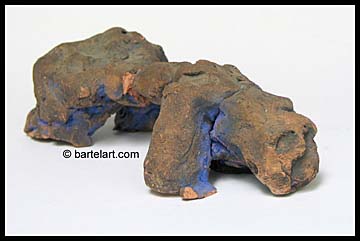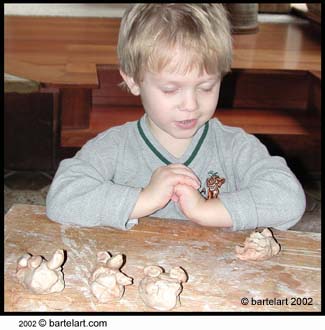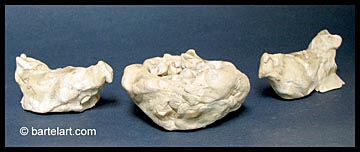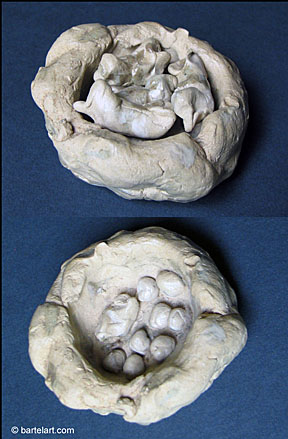Today’s urban toddlers come with the same instincts and motivations as children in any tribal village. A toddler’s mind has the same needs to create imaginary tools, cooking vessels, animals, dolls, and so on. These are used in imaginary play as they learn about and practice coping with the worlds into which they are moving. A child that learns at an early age that anything that can be imagined can be created is more likely to be more creative and intelligent than a child that only plays with manufactured toys that have been designed by adults. Clay, like almost no other material, allows the immediate materialization and realization of the imagination at virtually any developmental level. Many toys are well designed for pretending and imaginary play, but not many are good for imagining and creating new objects and new toys. Beginnings When giving clay to a very young child the first time, I do not instruct the child on what to do with the clay except to clarify that it is to play with—not something to eat. Other than making sure they do not eat it or throw it, I simply watch to see what hey do with it. Good adult supervision consists of observing and encouraging self-initiated experiments that correspond to reasonable limits of play. Some children are ready to plunge in and try anything and other children are shy. Young children are very good at reading us. They imitate our actions. If a child is too hesitant, I let the child watch me explore the lump of clay myself. I encourage them that it okay to pinch it, poke it, pound it, and so on. Since some children have learned to avoid getting messy, I show them how easy clay wipes off my fingers with a moist cloth or sponge. Sometimes they will just practice wiping the clay off their fingers at first. This is fine. It is learning. If the child is very young, it may be best to wait and try it again each month until you feel comfortable with the child’s responses. The child will love to do things that make you happy, so express your satisfaction and joy with any exploration, experiments, and activities that the child invents. They do not have to make a piece of pottery or sculpture to make us happy. We just want to see them enjoying themselves. Children that are too young to walk might be in a playpen or sit strapped in a small table. This is also a way to confine them if they are prone spread the mess too much. If I do not want the child to throwing the clay, I will explain that the clay is too messy to use as a ball. I will encourage a different experiment like making holes in the clay, pounding the clay, or sticking pieces of clay together instead. Once children begin to make things from the clay, I might ask, “Can the clay be a baby?” “Does the clay like to look at its mommy?” “Can you make eyes in the clay?” “Do you think the clay likes to eat things?” “I wonder how the clay could play or walk?” I want to see if the child can invent dolls, toys, and so on with the clay. I can use questions to help direct the child’s thinking in a positive mind building direction. I avoid being negative. If anything negative happens, I divert the activity to positive alternatives rather than using punishment. I can move directly to questions that remind the child of positive and constructive ideas (see questions under Motivation below). These questions use the knowledge that every child already has and helps the child focus this knowledge on a constructive creative activity. As they see their clay take shape, it stimulates their imaginations to take it the next step. As an observer, I am able to ask the next open question to motivate an imaginary play sequence. Motivation for Thinking and Creativity Most of the time I keep my hands off the clay. Very little instruction is needed. The things they make are generally not kept or fired. If something is fired, it can be glued after firing if it comes apart. The clay is kept soft between sessions by adding a small amount of water before storage in airtight plastic bags or containers. As adult observers, caregivers, or teachers, we can play the role of artist’s muse. With a little thought and practice, any adult and even an older sibling can learn to lead a child’s creative thinking. Toddlers create from what they already know, but our questions help bring appropriate details to their consciousness as they work. As muse, I do not show children what to do or what to make. As muse, I am not really trying to teach them how I would make something—I am trying to inspire them to develop and express their own ideas. I am coaching the child in thinking. I want to raise possibilities by asking open questions (questions with several answers). With just a lump of clay, my open question helps the child turn it into a person’s face invented by the child without me saying anything about a face. Using the child’s name, I might ask, “Is this Amy? How does Amy look at things?” Often a child will poke the clay and make one or two eyes. I might ask, “That’s nice. How many eyes does Amy have?”
When the child has advanced a bit and created a head with legs (a baby, a self, or a doll), my open question might ask, “Whom would the baby (or girl or boy) like to play with?” Soon the child will be busy creating a playmate. The child may then carry on a dialogue between the two clay toys. With a bit of practice, this kind of creative thinking and making becomes second nature for the child. Adult supervision can become more and more passive—only needing to express profound wonder and amazement to urge the child to continue the creative play with the pretend theater of characters. With more open motivational questions, it may soon become elaborated with props such as clay cooking pots, cars, trucks, and so on all made as needed.Often children do not need any of the motivational questions. If I notice that a child is intently working, I hang back. I watch from a distance and wait until the child seems finished.
Notice: © 2006 Marvin Bartel. All rights reserved. If this copyright is included, you may print one copy for personal use. Those who wish to make more copies or publish any part of this electronically or otherwise must get permission to do so. Your responses are invited. Updated: July, 2011. Contact the author -- Author bio Visit these pages for many more ideas. Art Education Links by the same author . Teaching Ceramics Marvin Bartel Marvin Bartel Home .
|
||||||||||||||
|
|
